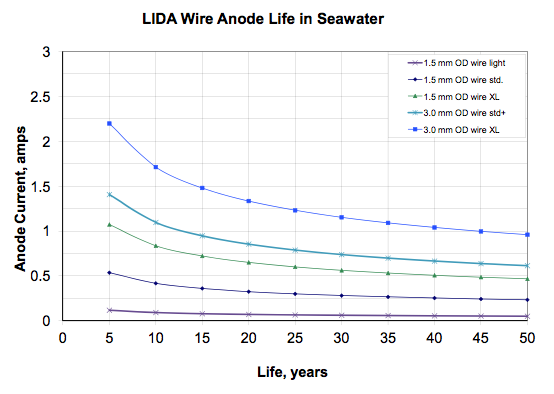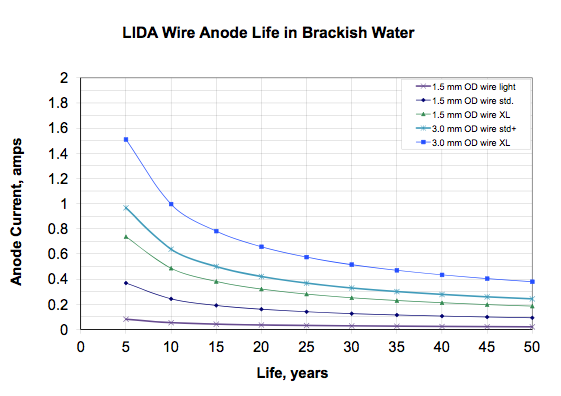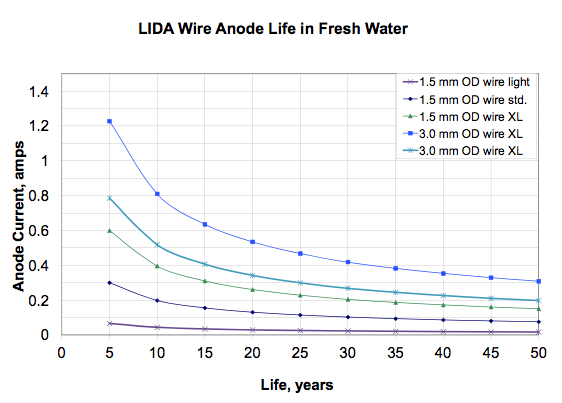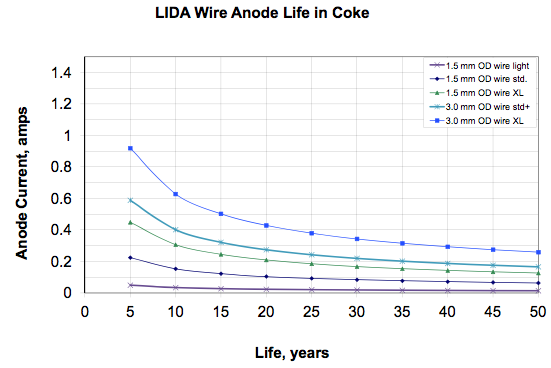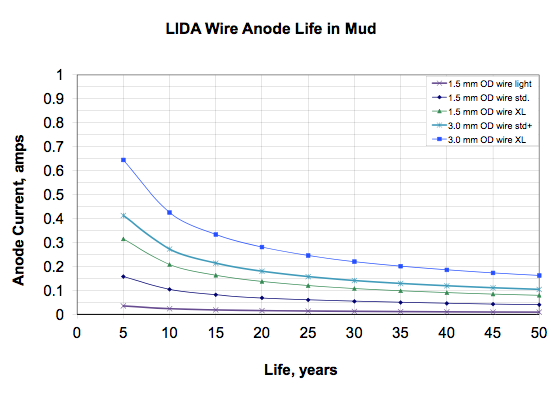Lida MMO Wire Anodes by De Nora Tech

- High Performance Mixed Metal Oxide Wire Anodes for C.P. Applications
-
LIDA wire anodes, by De Nora, are made of copper cored, titanium wire with a mixed metal oxide (MMO) coating. The mixed metal oxide is a crystalline, electrically conductive coating that activates the titanium and enables it to function as an anode. The anodes are manufactured in two standard diameters: 1.5 mm (0.06") and 3.0 mm (0.12").
When applied on titanium, the coating has an extremely low consumption rate measured in terms of milligrams per year. As a result of this low consumption rate, the wire diameter remains nearly constant during the life of the anode.
The low consumption rate of the mixed metal oxide coating, at the recommended operating current densities, results in projected anode lifetimes from 15 to 20 years. Longer or shorter lifetimes may be obtained by varying the current output per foot of wire. This information in demonstrated in the accompanying graphs, which relate amperes per lineal foot to lifetime in years.
While the LIDA anode wire is available in 1,000 foot reels from the factory, Farwest can customize the anode wire for easy field installation. This includes fabrication for canister applications, "piggy-back" systems for undertank or linear anode projects and more. Contact a Farwest Corrosion representative for help in your design needs.
Anode Coating
The MMO coating used on the andoe wire is suitable for most cathodic protection applications, but output varies with application. De Nora's mixed metal oxide coating demonstrates a very high chemical stability, even in environments with low pH values. Unlike other impressed current anodes, the De Nora coating is not affected by the generation of chlorine.
Applications
- Canistered Anodes
- Continuous Horizontal Groundbeds
- Discontinuous Horizontal Groundbeds
- Shallow Vertical Groundbeds
- Above Ground Storage Tanks
- Underground Storage Tanks
- Natural Water
- Electrical Cable Shielding
- Water Storage Tanks
- Water Treatment Equipment
Features & Benefits
- High Current Output
- Low Coating Wear Rate
- Highly Conductive Copper Core
- ANSI/AWWA Standard D 104-91
- Lower Cost Per Ampere Year
- Constant Electrical Resistance
- Minimizes Voltage Drop
Typical Lead Wire Connection Detail
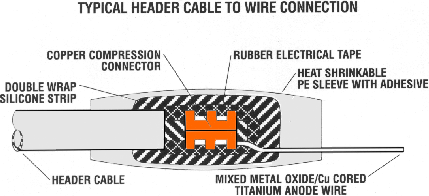
A typical connection between the LIDA wire anode and a header cable is shown below. Connections such as this have been used successfully in canistered anodes since 1987.
-
Resistivity vs. Anode Length
Proper current distribution is an important factor in the design and proper use of an anode wore for each application. The graphs of Electrolyte Resistivity versus Maximum Wire Length are shown for selected voltage drops down the line. The voltage drop values represent the percentage decrease in actual driving voltage for the beginning to the end of a particular anode system.
For example, if a wire voltage drop of 10% or less is desired for proper current distribution in 1000 ohm-cm water, anode segments 45 feet should not be exceeded between electrical connections to a header cable with the 1.5 mm diameter wire. By comparison, use of the 3.0 mm diameter wire will permit the use of 110 foot segments, while still allowing the desired 10% voltage drop.
As with all electronic conductors, the operating temperature of the wire affects the resistance. The table shows this effect by assuming the wire will operate at the temperature of the surrounding electrolyte. The change in resistivity also changes the maximum current handling capacity of the wire.
Wire Size (mm) 1.5 mm dia. 3.0 mm dia. Resistance, ohms/meter @ 25oC
0.0188 0.0034 Resistance, ohms/meter @ 70oC
0.0221 0.0040 Max Wire Amperage @ 25oC
21 36 Max Wire Amperage @ 70oC
7 7 -
Regardless of the type of impressed current anode used, proper anode bed design is paramount to optimum, low resistance performance. For soil applications, De Nora Corporation recommends the use of quality, conductive, carbonaceous backfill, a vent pipe, and centralizers, suitable cable, and good design practices and understanding.
-
Anode Design
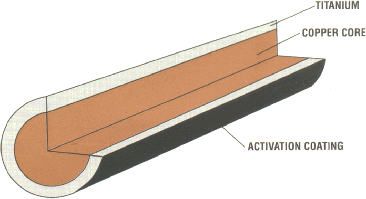
Reliability
De Nora wire anodes are coated in the United States. They are lightweight, rugged, and flexible. De Nora wire anodes have been used successfully in canistered form since 1987 and in tank bottom protection systems since 1990. In choosing De Nora wire anodes, you have selected the most durable and reliable material from the originator of the mixed metal oxide anode.
SavingsFlexibility of Use
In many cases, De Nora mixed metal oxide wire anodes offer savings over competitive anodes on an installed cost basis. This is possible by balancing the high current density capability of mixed metal oxide coatings and the ability to tailor to desired lifetimes. De Nora wire anodes can be used in a wide variety of cathodic protection applications. Their lightweight and malleability allow forming to complex configurations. The copper core provides high conductivity resulting in better current distribution along the entire length of the wire.
Quality Assurance Ordering Information
From the application of the coating to the spooling of the wire, De Nora's attention to quality sets it apart. The coating undergoes stringent quality control examination by SEP, X-ray and adhesion test methods throughout the coating process to assure proper thickness and application. Attention to each detail of the quality control process assures you a superior, reliable product. De Nora wire anodes are available from Farwest Corrosion. When ordering De Nora wire anodes, please specify:
- Wire diameter
- Wire length (maximum single piece length is 1,000 feet, except by special order)
- Cable lead, if any
- Splicing requirements
- Application
- Custom needs

